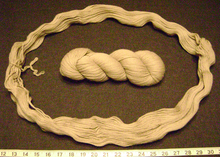Hank (unit of measure)
In the textile industry, a hank refers to a unit of yarn or twine that is in a coiled form. This is often the best form for use with hand looms, compared to the cone form needed for power looms. Hanks come in a fixed length depending on the type of material, so the term hank is sometimes used as a unit of measure. For instance, a hank of linen is 270 meters, and a hank of cotton or silk is 768 meters. In beads, 1 hank = 3.333 fathoms = 6.667 yards = 20 feet = 6.096 meters.


In yarns for handcrafts such as knitting or crochet, hanks are not a fixed length, but are sold in units by weight, most commonly 50 grams. Depending on the thickness of the strand as well as the inherent density of the material, hanks can range widely in yardage per 50 gram unit; for example, 440 yards for a lace weight mohair, to 60 yards for a chunky weight cotton. Special treatments to the materials that add cost, such as mercerisation or labor-intensive hand-painting of colors, can influence a manufacturer's desired length per unit as well. Knitters and crocheters rewind the hanks into balls or center-pull skeins prior to use, in order to prevent the yarn from becoming tangled.
